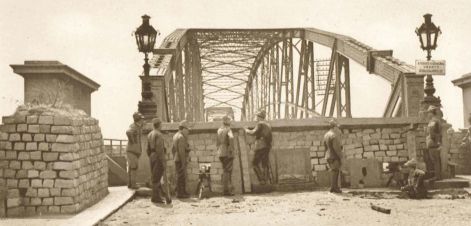Komárno
A little town in Slovaki in The Eurpean Union
The 20th century
Komárom's recovery began at the end of the 19th century and beginning of the 20th century, when construction of iron bridges across the Danube and Váh began as well as the first railway lines linking Komárno to the rest of Austro-Hungary. It soon became an important transport junction, attracting industry and trade. In 1896 the town of Újszőny on the south side of the Danube was combined with Komárom, allowing the town to expand its territory and development across the Danube.
With the disintegration of the Austro-Hungarian Monarchy after World War I, Komárom found itself under new rule. The forming of Czechslovakia, whose natural border in the south became the Danube River, separated Komárom from its southern half. In 1919 (confirmed by the Treaty of Troanon in 1920), the territory to the north of the Danube was ceded to Czechoslovakia with the territory to the south of the Danube remaining in Hungary. The town on the northern shore was renamed to Komárno (today the Slovak name of the town), and in 1923 it was reduced from a county seat to a district seat. Although this resulted in a dramatic change in the national composition of Komárno, the majority remained Hungarian.
n fact Komárno became the center of cultural and social life of the Hungarians in Czechoslovakia. In 1938, under the First Vienna Award of that year, Komárno (now again as Komárom) was returned to Hungary. Its former name and status of town and county seat of the Komárom county was restored. At the onset of World War II Komárom/Komárno became a military center for the Germans and eventually the frontline for the Germans defending the oil refineries to the south. Although there was no heavy fighting in the Komárno area, it was bombarded several times. The bridges connecting the two territories were destroyed and most of the territory lying on the south bank of the Danube lay in ruins. After the WW II the territory on the north bank of the Danube became part of Czechoslovakia again and the town name was changed to Komárno. After the war, large-scale reconstruction of Komárno's industries began. The reconstruction of the shipyard, the town's largest industrial facility, was completed in 1950 and greatly promoted the economic development of the town. New factories were constructed in the west side of town near the shipyard creating a new industrial district. An urban development plan was implemented as well. Residential districts were created with new housing estates and wide roads were laid across the town.



Honlapkészítés ingyen:
Ez a weblapszerkesztő alkalmas
ingyen weboldal,
ingyen honlap készítés...
Mai: 1
Tegnapi: 3
Heti: 1
Havi: 17
Össz.: 7 310
Látogatottság növelés
Komárno - © 2008 - 2026 - komarominenglisch.hupont.hu
